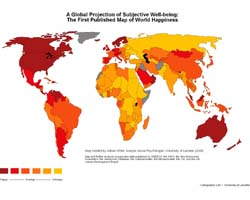We’ve reported on some happiness and subjective wellbeing research earlier. [See also this post and this], including this post on how the UK government is starting to track happiness with a goal of increasing national well-being.
John Helliwell, emeritus professor of economics at UBC and co-director of a CIFAR panel looking into Social Interactions, Identity and Wellbeing, was at Harvard yesterday summarizing his and others’ recent research on happiness research, with special attention to the social context of well-being.
John is a relentlessly upbeat and positive person, messianic in his message, but also a hard-nosed social scientist. [With regard to happiness, it’s reminiscent of the “When Harry Met Sally” scene, where another dinner seeing Meg Ryan in ecstasy says “I’ll have what she’s having.” Only in John’s case, unlike Meg Ryan’s, his happiness is heart-felt.] He had the group singing “If you’re happy and you know it clap your hands” and noted after the group sing that research shows that doing things with others, especially making music, is great for increasing happiness, as any choral group member can affirm.
He observed that the amount of data and experimentation regarding happiness research is in its infancy but suspects that the three major points about happiness that will ultimately emerge are:
1. The positive trumps the negative. So much of our society is built around the negative: treating the sick rather than preventing sickness, enacting laws to deal with failures, imprisoning transgressors,… But Helliwell thinks we haven’t focused enough on “wellness” studies, observing what ensures that things actually work and make people happy. How does the positive trump the negative? For example, autobiographies of nuns in their 20s were parsed for emotional content and positive emotional content was found to be predictive of longevity. Similarly, mid-life members of the American Psychological Association, whose most important research finding represented something positive rather than negative, also lived longer, controlling for other likely factors.
2. Community trumps materialism. Partly because of advertising and economics, we chase materialism, thinking that a larger house or higher salary will bring us happiness, and in the process live somewhere necessitating a longer commute, less sleep, and less time spent in community. In these Faustian bargains, we wind up less happy rather than more so. Helliwell and Huang have found that a 1% improvement in a worker’s relationship with the boss improves happiness as much as a 30% increase in salary. Helliwell noted an experiment that showed that even the act of rowing together improved happiness.
John noted that he is working with Ed Diener, the CDC, and the Robert Wood Johnson Foundation on an effort to get clinicians to ask community-connectedness and wellbeing questions as part of intake exams by physicians.
3. Generosity trumps selfishness. People who give away more of their wealth, regardless of income, feel happier than those who give away less. Similarly, those who did favors for others in the last year felt happier than those who received favors in the last year. The largest happiness effect is seen when people do things for someone together with other people.
Some other observations of Helliwell:
Negative role of media in this process: 2% of Canadians had actually been a victim of crime in the last year but 20+% expected to be in the next 12 months. Similarly, 24% of Toronto residents thought that a stranger would return a lost wallet, when in reality, an experiment showed that 80% did. Because we’re less connected with others, we rely much more on the media and the media is largely selling negative news.
Role of income: Worldwide, there is a decent correlation between levels of happiness and levels of income.

Map of World Happiness – Adrian White, Leicester; happier places in darker red
But the fact that income and happiness appear related is NOT because the relationship between income and happiness is all that strong, but because the levels of income between say Africa and the US are so different. Many other factors are greater predictors of happiness, like trust of others, social connections, lack of corruption, sense of freedom, religiosity, enough money for food, and social support networks. It is only because these stronger predictors are not higher in say Africa than the US that income looks to be strongly influential.
If one compares say provinces of Canada against each other (Helliwell is Canadian, hence all the Canadian references), income levels do not explain which provinces are happier. The happiness differences are much more about community connection and involvement. The wealthiest provinces (like Ontario where Toronto is or BC where Vancouver is) are the least happy, and some of the poorer provinces like the Maritimes (NE of Maine) are the most happy. While the differences in happiness are not huge between say the Maritimes and BC, it would take a 150% increase in salary to produce the same increase in happiness. Helliwell says the answer is not a question of people from Toronto moving to St. John’s (Newfoundland, Canada), but learning and copying the activities and actions that make folks in St. John’s happy. In fact just having the Toronto residents move to St. John’s is likely to make everyone less happy.
[Helliwell noted that there is one study comparing levels of happiness across US States by Andrew Oswald and Stephen Wu, but Helliwell expressed some skepticism in the happiness data they used. The study found high levels of happiness in Louisiana and low levels of happiness in NY, Connecticut and NJ.]
Helliwell said that work is still being done on the relationship between income and happiness. At a national level, with World Values Survey data, he and Putnam found that around the median level of OECD (developed) countries, income stopped having much of an effect on increasing happiness. Some other more recent data (Gallup World Poll) suggests that a log-linear relationship of income to happiness continues with no declining returns to income. Helliwell noted that Deaton and Kahneman found declines in affective (emotional) subjective wellbeing after an intermediate level of income in these same Gallup data, but no decreasing returns to income in cognitive life satisfaction. Helliwell also noted that raising income of some within a county is not a productive strategy for increasing income since those whose income is raised are happier but others are less happy, in other words it is zero-sum. In contrast, if you are more socially connected into one’s community, both you and your community members are happier, even if they are not socially connected (positive externalities).
In world rankings of happiness, Denmark is #1. Canada is higher in happiness than the US (even with lower per capita income) mainly because of the lower perceived levels of government corruption in Canada.
Helliwell believes that a participatory process is key to happiness. Alex Haslam, a social psychologist, has done interesting experiments here. In one experiment, an eldercare facility had a “happy floor” and an “unhappy floor” (for reasons they couldn’t determine). They were moving into a new facility and had the “happy floor” get a professionally designed new environment. The “unhappy floor” was assigned to work together to design their own new floor. While professionals scoffed at the design that the “unhappy floor” came up with, in the new facility, the “unhappy floor” became happier in the new facility than any other floor. (Haslam and colleagues call this collective self-realization.) In a second experiment, they randomly assigned some workers to get a first-rate professionally designed cubicle, some to get an average professionally-designed cubicle, and some to design their own cubicle within a given budget. While the professionals similarly scoffed at the self-designed cubicles, the workers in these cubicles were far happier than either of the other two groups. Helliwell thinks that the biggest gains would be workers collectively designing the public spaces at the workplace.
Another experiment with a Singapore prison (called “Captains of Lives and Yellow Ribbon Project”) converted it from being a place of punishment to a place to reintegrate people back into society: they held cooking competitions with residents from the community, jogging races together, etc. They found that recidivism rates (re-entry of prisoners back into prison once released) declined dramatically to 25% and that staff retention in the prison rose (since the staff had completely redesigned roles).
Helliwell believes that the art of community connectedness is inherently learnable. He notes that it does take an unusual combination of empathy and nerve (since by suggesting to someone that they attend a block party or do something you run the risk of being rejected). He said this spirit of engagement is infectious. He noted that he gave his talk in the Maritime provinces and asked someone from St. John’s whether other St. John’s residents ever flipped him the bird when driving; the person replied, “No. If someone gives us the finger, they must be from out of town.” Helliwell commented that two people giving each other the finger in rush-hour traffic both go home less happy (a negative externality) whereas two people waving to each other in traffic both go home happier.
– With regard to immigration, he noted that immigration challenges community levels of happiness since it is harder for immigrants to get involved and be connected (since they have severed many friendships and community ties through their migration, and since they may have language issues and severe time constraints to getting involved if holding down multiple jobs). He thinks the answer is multiculturalism and pointed to the work of Irene Bloemraad. He thinks that rather than artificially positing that bonding social capital (the ties of immigrants to each other) and bridging social capital (the ties of immigrants to natives) are zero-sum, that instead the happiest immigrants have significant levels of both bonding and bridging social ties. [In other work we have done, it appears that the bonding ties often precede the bridging ties and it is not until immigrants feel that they have their own bonding support networks that they feel comfortable reaching out.]
Our inability to learn from the experiences of others. Heliwell was asked about research by Dan Gilbert; Gilbert found in experiments with Harvard students, that new students continued to take paths that gave them greater choice (thinking it would bring them greater happiness) even when presented with data from prior cohorts of Harvard students indicating that greater choice brought them less happiness. In other words, they couldn’t learn from others’ experiences about how to achieve happiness. Helliwell described an experiment by Dan Ariely and others in priming: most people cheat slightly in their self-scoring of tests, but students who were asked to recall as many of the Ten Commandments as they could before scoring their tests, scored themselves accurately. Even if we can’t get people to change their erroneous thought processes (e.g. more choice = more happiness), through priming Helliwell believes that we may be able to change behavior.
– He was asked whether parents are the least happy group and what the impact of children is on happiness. Helliwell said it is hard to ferret out. Most people exhibit a U-shaped lifecycle for happiness: they are happiest in their youth and retirement and less happy in middle age. The shape of the curve may depend a lot on governmental policy — how much they support people in their elder years. Child rearing typically occurs when people are less happy anyway, but he thinks it is not children that are bringing them unhappiness, but the competition and conflict people in those years feel between their roles (work, parenting, relationships, homeowning, etc.). He noted that the loss of a child brings extreme depression (suggesting how much children are valued), and while he said he has not seen great data on this, he suspects that children and grandchildren bring great happiness in retirement years.
– Helliwell also asserted that several “set point” theorists had abandoned their claims in the face of better data. The “set point” theorists have argued that everyone has some baseline level of happiness (some are relatively happy, some unhappy) and that good or bad events (winning a lottery, losing a leg) momentarily dislodge a person from their set point but they return to their baseline level of happiness over a period of months or years. Helliwell says that the data do not support this notion that we adapt to everything. [See also Andrew Oswald’s work in 2007 on lottery winners and interview with Sharon Begley.]
He closed by suggesting that we should treat each elevator ride as a place for experimentation rather than a brief prison sentence.
[Good summary post on the Atlantic by Derek Thompson based on analysis by the New Economics Foundation of 10 things economics can tell us about happiness. Things associated with higher happiness: being wealthy (but only to a point); higher public spending; going from part-time to full-time work; and self-employment. Things associated with lower happiness: income inequality; inflation; unemployment; credit card debt; working more hours (if already working full-time); and longer commutes.]
 The United Nations held a historic UN Conference on Happiness on April 2 to discuss wide discrepancies in levels of happiness worldwide and whether countries should track happiness in addition to other more standard economic measures. The meeting drew 600 delegates, including leaders and scholars from around the world. The main consequence of the meeting, in addition to exploring what is known about happiness research was to focus on happiness and wellbeing at the Sustainable Development Rio+20 conference in June. It is also likely that when the new new Sustainable Development Goals come out in 2015 (a re-working of the Millennium Goals) happiness will be on the list of priorities, joining the stalwarts like anti-poverty and educational goals.
The United Nations held a historic UN Conference on Happiness on April 2 to discuss wide discrepancies in levels of happiness worldwide and whether countries should track happiness in addition to other more standard economic measures. The meeting drew 600 delegates, including leaders and scholars from around the world. The main consequence of the meeting, in addition to exploring what is known about happiness research was to focus on happiness and wellbeing at the Sustainable Development Rio+20 conference in June. It is also likely that when the new new Sustainable Development Goals come out in 2015 (a re-working of the Millennium Goals) happiness will be on the list of priorities, joining the stalwarts like anti-poverty and educational goals.





 French President Nicholas Sarkozy, convinced that GDP was not properly measuring French citizens’ well-being, appointed a 25-member blue-chip commission (chaired by Nobel Laureate Joseph Stiglitz, and largely composed of the world’s best economists, including 4 other Nobel Laureates) to advise him on whether GDP adequate mesured well-being and, if not, what else to measure. [The findings are
French President Nicholas Sarkozy, convinced that GDP was not properly measuring French citizens’ well-being, appointed a 25-member blue-chip commission (chaired by Nobel Laureate Joseph Stiglitz, and largely composed of the world’s best economists, including 4 other Nobel Laureates) to advise him on whether GDP adequate mesured well-being and, if not, what else to measure. [The findings are